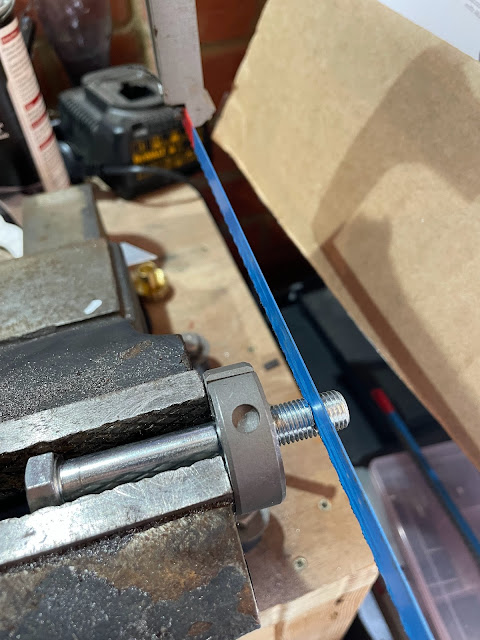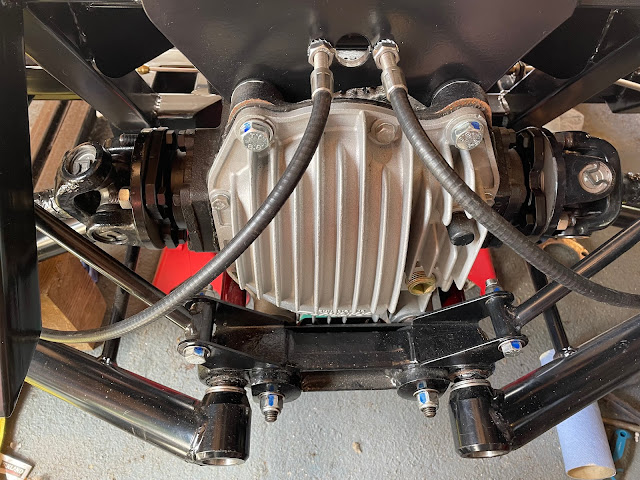Finally, I am at the last stage of getting the rear axle/suspension back together and be warned this stage is a right PITA.
The first job on the list was to set the rear camber. This requires setting the top most point of each of the rear hubs to be 150mm below the top of the rear chassis rail, checking the vertical angle of the face of the rear hubs and adjusting (by inserting shims between the differential output flange and the inboard half shaft flange) until the camber of the rear hub is between 0 and 0.5 degrees negative camber.
There now follows a moment of monumental stupidity which I am amazed I am prepared to admit to on such a globally viewed forum.
There are a couple of options for shimming out the half shafts on a Jaguar rear axle.
- Spacers of a specific thickness. Jaguar used spacers of between 3.5 and 7.5mm thickness with Part Number CBC4806xx, where xx is the spacer thickness (e.g. 35 for the 3.5mm spacer). Although these are only made out of steel, at the price they cost, you would think they were made out of gold!
- Rear camber shims with Part Number C16621#. These are 0.020" (approx 0.5mm) thick and cost less than £1 each
I went with the second and cheaper option and ordered 16 shims from SNG Barratt hoping that would be a sufficient number (giving me up to 4mm of shim on each side).
 |
| 16 Rear Camber Shims for less than £20... |
I jacked up the first rear hub until it was 150mm below the top of the chassis rail. I did this by clamping a spirit level to the top of the chassis rail and setting an adjustable set square on top, with the ruler set to give a depth of 150mm below the bottom of the spirit level. The hub was then jacked up until it just touched the bottom of the ruler.
 |
| Setting height of hub to correct level |
I then checked the vertical angle of the hub using a digital spirit level set vertically across the edges of the centre spigot on the hub. The first reading was 89.25 degrees (i.e 0.75 degrees of negative camber), slightly too high, so some shimming was required.
I found an article on one of the online Jaguar forums that suggested that each 0.5mm shim would adjust the camber angle by around 0.25 degrees. So theoretically I only needed to add one shim. In reality, I needed to add a few more as, without any shims in place, there is a small flange on the back of the inboard half shaft that bears onto the differential output shaft flange, such that at the point where the bolts pass through there is a gap between the two of around 3.5 to 4mm. Until that gap is filled, the rear camber shims won't actually have any effect at all.
So I undid the nuts on the inboard half-shaft, which is a bit of a pain as you have to get it in exactly the right spot to get a 7/16" socket in through the U-joints and then you have to turn the differential by hand to line up each nut for removal (and of course repeat the process when you put the nuts back on).
With the half-shaft eased away from the differential flange bolts I could slide on a couple of shims, tighten it all back up and recheck the camber. Except I couldn't because the hole pattern in my shims did not match the bolt pattern on my differential output flange; two of the holes matched up, but two were way out.
Cue much swearing...
In order not to waste the whole afternoon, I rummaged around in my box of leftover donor parts and found the two original (thick) half shaft spacers. So I decided to install those just to try and get an idea of what thickness of shimming I was going to need. After a frustrating and knuckle scraping afternoon of removing and reinstalling the half-shafts on both sides (several times), I had concluded that I was going to need around 4-4.5mm of shims on the offside and 7-7.5mm of shims on the nearside.
Later that afternoon I logged onto the SNG Barratt website to check out spacer options again. This time I entered the VIN number for my donor vehicle and surprisingly the rear camber shims that I had already bought, did not come up as an option. The only options were for the fixed-thickness spacers made of gold. Clearly, I thought, the rear camber shims are for a different year model which has a different bolt pattern.
Annoyingly the spacers were also all on Special Order from SNG. However, I found them in stock at Jaguar and Landrover Classic Parts. I decided to order a 4mm and a 7mm spacer and then if necessary I could cut up the rear camber shims in such a way as to make one spacer out of two (or more) if additional thickness was needed. BTW these two spacers cost over £100...
While I was waiting for the new spacers to arrive, I decided one evening to try and work out the best way to section up my original shims to try and make up a single shim from bits of others.
It was then that my moment of stupidity hit me right between the eyes...
 |
| Why would they change the bolt pattern... |
 |
| ...Oh wait - they didn't...Doh! |
Still...on the plus side, with needing nearly 12mm in total of shimming, I didn't have enough rear camber shims in any case plus its probably better to have a solid spacer rather than a large number of the thinner shims, particularly on the side needing nearly 8mm of shim (which would be 16 of the rear camber shims).
So maybe it has all worked out for the best!













































